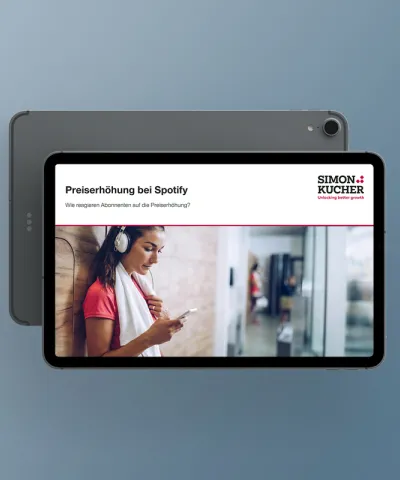There are many reasons to add agility to your business through price – from applying systematic differentiation to access wider market segments and willingness to pay, to using dynamic pricing for alignment with market and cost fluctuations. In part five of our resurgent crisis series, we look at pricing agility through both a B2B and B2C lens, sharing multiple industry examples and practical tips for quickly and effectively implementing pricing.
Systematic price differentiation or one-size-fits-all?
With profits now key to survival, the crisis has given many companies the well-needed motivation to revise their pricing strategies. But even in stable market conditions, differentiation has proven to be an effective tool for monetizing value. It can be achieved by developing different offerings to cater to customer segments, or based on situational factors to tap into willingness to pay, e.g. on- and off-peak usage. In B2B environments, differentiation can be based on each customer’s potential and risk, factoring in their profitability, tenure, potential business, and strategic importance.
When can you use dynamic pricing?
In one of our webinar polls, business leaders rated dynamic pricing as the most agile form of pricing, where the price of a given good or service fluctuates to reflect chaFnges in the market. Dynamic pricing can be used to:
- Incentivize an earlier purchase: Used to steer demand early on, low-priced tickets are offered for advanced bookings, but prices escalate as the percentage of capacity booked increases.
- Tap into different willingness to pay: Advance bookers are often more price-sensitive than those who book last minute, and dynamism makes it possible to cater to both segments. Prices can also differ by season and occasion, with willingness to pay depending on the weather or specific calendar events.
- Monetize or incentivize supply: Dynamic pricing can be crucial to guarantee the value of a product or service, acting like a balancer on the overall demand ecosystem. This is how Uber’s pricing works. When demand goes up, prices increase to monetize and incentivize supply. Without surge pricing, it would take ages for a taxi to arrive, degrading the product value.
- Incentivize the purchase of perishable stock: Using electronic price tags, dynamic pricing can be a cost-efficient way of minimizing waste of perishable products with an expiry date. It can also be used to shift products quickly in cases of oversupply.
By fulfilling all of these criteria, airlines have succeeded with dynamic pricing since the 80s. Their inventory by nature is perishable, as once a plane leaves, seats cannot be sold. Prices on global distribution systems can be changed digitally. There is seasonality of demand, as well as a difference in willingness to pay, e.g. leisure vs. business customers, and early vs. last minute bookers. However, nowadays, other businesses are proving that even just one criterion can be enough to succeed. From ecommerce giants to app disrupters, and even traditional retailers, dynamic pricing is being applied across a much wider spectrum of businesses.
Of course, not all industries are ready for full-blown dynamic pricing, especially if your business involves watertight contractual agreements. But rules based on basic indicators can already go a long way. Even in B2B, simply tracking and adjusting prices on a monthly basis adds a layer of agility. It's not as dynamic as the price changing every hour or day, but it's still dynamic in the sense that pricing is oscillated to reflect the market. You can also empower the sales team to make decisions that defend pricing by providing target, escalation, and limit prices for negotiations based on capacity and demand surges, or use promotions to change the price that a customer pays without changing the actual price tag.
And remember: the aim is not to have machines take over. If a surge is driven by an unfortunate event, a rise in prices will likely be seen as profiteering. Checks and caps need to be in place, and systems need to be recalibrated when history cannot to be relied upon, like in this resurgent crisis.
How to master the organizational side of pricing?
Most companies believe they have a sufficient process in place for making pricing decisions. However, if sporadic pricing meetings keep dragging over scheduled time, people talk about “projects” instead of “products”, and you follow typical waterfall designs rather than pushing incremental evolution, you probably aren’t in an agile environment.
Four steps to building an agile pricing organization:
1: Identify triggers for pricing actions
A pricing trigger model will give you early warning signals whenever something changes in the market. Set up SaaS reporting tools for a weekly, decentralized status review. This can include a demand forecast based on internal and external data, macroeconomic indicators, early sales funnel analytics, competitive behavior, churn trends, and customer feedback. Rather than duplicating your controlling, these KPIs should be based on your commercial and pricing activities.
2: Agree on reaction to pricing triggers
For clear direction on how to respond to a pricing trigger, your teams will need a “pricing playbook”, including scenario planning and remedies to specific pricing problems. Our experience from thousands of pricing projects shows that superior playbooks systematically factor in customer feedback. The key steps for a customer-led “pricing playbook” can be summarized as follows: systematically listen for customer feedback, identify and understand trends, benchmark to understand risks and opportunities, and then derive or adapt strategies to respond.
3: Execute pricing actions
Companies that learn how to distribute decision-making have a significantly better chance of keeping up with today's challenges. Employees need to be able to react quickly without being bogged down in internal bureaucracy. Ensure you have pricing competencies at every level, from price leaders who define the long-term strategy and review performance, price managers who define the “rules of the game”, and price executers who make daily pricing decisions based on the abovementioned KPIs and pre-defined playbook.
4: Review impact in agile teams
Finally, you need to constantly track and review your actions, creating an “agile learning loop”. Performance monitoring should be supported by KPI dashboards, as well as regular cross-functional meetings attended by revenue management, marketing, business intelligence, sales, etc. This will enable you to assess the impact of previous measures, forecast upcoming scenarios, and adjust pricing accordingly.
Achieving an end-to-end digital pricing solution
For all of these recommendations to work in practice, a key aspect of agility is having speed and efficiency along the pricing value chain. Cumbersome procedures create bottlenecks in the execution phase and should be standardized or automated. If your time-to-quote is two weeks and your competition can do it in two hours, then you have a problem. Moreover, agile pricing approaches need to be supported by data. Establish expert groups to centrally drive and scale analytics across business units, and consider the use of artificial intelligence for analyzing data patterns. The goal is to have an end-to-end digital pricing solution at your fingertips which allows you to react in time, before today’s news becomes old news. Take the right steps toward pricing agility today, and your efforts will be valuable as the crisis continues to take shape.








